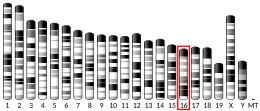SNAI2
SNAI2아연 손가락 단백질 SNAI2는 사람에게서 SNAI2 유전자에 의해 암호화되는 전사 인자이다.그것은 특정 세포의 분화와 이동을 촉진하고 위 [5][6][7]조절을 시작하는 역할을 한다.
기능.
이 유전자는 C2H2형 아연 손가락 전사 인자의 달팽이 슈퍼패밀리의 일원을 암호화한다.암호화된 단백질은 E-box 모티브에 결합하는 전사 억제제 역할을 하며 또한 유방암에서 E-카데린 전사를 억제할 가능성이 있습니다.이 단백질은 상피-간질 전환에 관여하며 항아포토시스 활성을 가지고 있다.그것은 태아에서 다른 유전자(예: FOXD3, SOX9 및 SOX10, BMP)와 함께 신경 파고세포의 분화와 이동을 조절한다.이 유전자의 돌연변이는 산발적인 신경관 [7][8]결손 사례와 관련이 있을 수 있다.
SNAI2는 E-카데린의 발현을 억제한다.따라서 SNAI2는 단단하게 결합된 상피세포가 느슨한 간엽 표현형으로 분열하도록 유도하여 발달 중인 [9][10]배아에서 중배엽의 위화를 가능하게 한다.구조적으로 C. elegans의 항아포토시스 Ces-1과 유사한, SLG는 발달 중인 배아와 [9][11]성인의 생산적 세포 사멸에 대한 음성 조절제이다.
임상적 의의
인체 조직에서 널리 발현되는, SLG는 말초 혈액 백혈구, 성인 간, 그리고 태아와 성인 뇌 [11]조직 모두에서 가장 두드러지게 결여되어 있다.SLG는 E-cadherin의 다운 레귤레이션에 의해 유방암뿐만 아니라 백혈병에서도 역할을 하며, E-cadherin은 I형에서 II형 카드헤린 [11][12]프로파일로 발현을 전환함으로써 간엽성 표현형을 지원한다.간엽성 표현형의 유지는 종양 세포의 전이를 가능하게 하지만,[9][10][11] SLG는 비침습성과 관계없이 암종에서 발현된다.병아리 배아를 사용하는 녹아웃 모델은 또한 중배엽과 신경 벼랑 박리 억제를 보여주었습니다; 병아리 배아의 민달팽이 기능의 증가는 신경 벼랑 생산을 [9]증가시키는 것으로 보입니다.Slug의 돌연변이는 일부 [9]동물에서 위배 기간 동안의 임신 상실과 관련이 있다.
상호 작용
BMP는 SLUG 발현에 앞서 유전자 [10][13]발현을 유도하는 직접적인 상류유도인자로 의심된다.
레퍼런스
- ^ a b c GRCh38: 앙상블 릴리즈 89: ENSG000019549 - 앙상블, 2017년 5월
- ^ a b c GRCm38: 앙상블 릴리즈 89: ENSMUSG000022676 - 앙상블, 2017년 5월
- ^ "Human PubMed Reference:". National Center for Biotechnology Information, U.S. National Library of Medicine.
- ^ "Mouse PubMed Reference:". National Center for Biotechnology Information, U.S. National Library of Medicine.
- ^ Rhim H, Savagner P, Thibaudeau G, Thiery JP, Pavan WJ (Jan 1998). "Localization of a neural crest transcription factor, Slug, to mouse chromosome 16 and human chromosome 8". Mammalian Genome. 8 (11): 872–3. doi:10.1007/s003359900601. PMID 9337409. S2CID 2177885.
- ^ Cohen ME, Yin M, Paznekas WA, Schertzer M, Wood S, Jabs EW (August 1998). "Human SLUG gene organization, expression, and chromosome map location on 8q". Genomics. 51 (3): 468–71. doi:10.1006/geno.1998.5367. PMID 9721220.
- ^ a b "Entrez Gene: SNAI2 snail homolog 2 (Drosophila)".
- ^ Stegmann, K.; Boecker, J.; Kosan, C.; Ermert, A.; Kunz, J.; Koch, M. C. (August 1999). "Human transcription factor SLUG: mutation analysis in patients with neural tube defects and identification of a missense mutation (D119E) in the Slug subfamily-defining region". Mutation Research. 406 (2–4): 63–69. doi:10.1016/s1383-5726(99)00002-3. ISSN 0027-5107. PMID 10479723.
- ^ a b c d e Nieto MA (March 2002). "The snail superfamily of zinc-finger transcription factors". Nature Reviews Molecular Cell Biology. 3 (3): 155–66. doi:10.1038/nrm757. PMID 11994736. S2CID 8330951.
- ^ a b c Carlson BM (2013). Human Embryology and Developmental Biology (5th ed.). Philadelphia, PA: Elsevier Health Sciences. pp. 101–102, 106, 313, 362, 382. ISBN 978-1-4557-2794-0.
- ^ a b c d Inukai T, Inoue A, Kurosawa H, Goi K, Shinjyo T, Ozawa K, Mao M, Inaba T, Look AT (September 1999). "SLUG, a ces-1-related zinc finger transcription factor gene with antiapoptotic activity, is a downstream target of the E2A-HLF oncoprotein". Molecular Cell. 4 (3): 343–52. doi:10.1016/S1097-2765(00)80336-6. PMID 10518215.
- ^ Kalluri R, Weinberg RA (June 2009). "The basics of epithelial-mesenchymal transition". The Journal of Clinical Investigation. 119 (6): 1420–8. doi:10.1172/jci39104. PMC 2689101. PMID 19487818.
- ^ Sakai D, Wakamatsu Y (2005). "Regulatory mechanisms for neural crest formation". Cells Tissues Organs. 179 (1–2): 24–35. doi:10.1159/000084506. PMID 15942190. S2CID 1886380.
추가 정보
- Maruyama K, Sugano S (January 1994). "Oligo-capping: a simple method to replace the cap structure of eukaryotic mRNAs with oligoribonucleotides". Gene. 138 (1–2): 171–4. doi:10.1016/0378-1119(94)90802-8. PMID 8125298.
- Savagner P, Yamada KM, Thiery JP (June 1997). "The zinc-finger protein slug causes desmosome dissociation, an initial and necessary step for growth factor-induced epithelial-mesenchymal transition". The Journal of Cell Biology. 137 (6): 1403–19. doi:10.1083/jcb.137.6.1403. PMC 2132541. PMID 9182671.
- Suzuki Y, Yoshitomo-Nakagawa K, Maruyama K, Suyama A, Sugano S (October 1997). "Construction and characterization of a full length-enriched and a 5'-end-enriched cDNA library". Gene. 200 (1–2): 149–56. doi:10.1016/S0378-1119(97)00411-3. PMID 9373149.
- Stegmann K, Boecker J, Kosan C, Ermert A, Kunz J, Koch MC (August 1999). "Human transcription factor SLUG: mutation analysis in patients with neural tube defects and identification of a missense mutation (D119E) in the Slug subfamily-defining region". Mutation Research. 406 (2–4): 63–9. doi:10.1016/S1383-5726(99)00002-3. PMID 10479723.
- Inukai T, Inoue A, Kurosawa H, Goi K, Shinjyo T, Ozawa K, Mao M, Inaba T, Look AT (September 1999). "SLUG, a ces-1-related zinc finger transcription factor gene with antiapoptotic activity, is a downstream target of the E2A-HLF oncoprotein". Molecular Cell. 4 (3): 343–52. doi:10.1016/S1097-2765(00)80336-6. PMID 10518215.
- Hemavathy K, Guru SC, Harris J, Chen JD, Ip YT (July 2000). "Human Slug is a repressor that localizes to sites of active transcription". Molecular and Cellular Biology. 20 (14): 5087–95. doi:10.1128/MCB.20.14.5087-5095.2000. PMC 85958. PMID 10866665.
- Hajra KM, Chen DY, Fearon ER (March 2002). "The SLUG zinc-finger protein represses E-cadherin in breast cancer". Cancer Research. 62 (6): 1613–8. PMID 11912130.
- Sánchez-Martín M, Rodríguez-García A, Pérez-Losada J, Sagrera A, Read AP, Sánchez-García I (December 2002). "SLUG (SNAI2) deletions in patients with Waardenburg disease". Human Molecular Genetics. 11 (25): 3231–6. doi:10.1093/hmg/11.25.3231. PMID 12444107.
- Kajita M, McClinic KN, Wade PA (September 2004). "Aberrant expression of the transcription factors snail and slug alters the response to genotoxic stress". Molecular and Cellular Biology. 24 (17): 7559–66. doi:10.1128/MCB.24.17.7559-7566.2004. PMC 506998. PMID 15314165.
- Catalano A, Rodilossi S, Rippo MR, Caprari P, Procopio A (November 2004). "Induction of stem cell factor/c-Kit/slug signal transduction in multidrug-resistant malignant mesothelioma cells". The Journal of Biological Chemistry. 279 (45): 46706–14. doi:10.1074/jbc.M406696200. PMID 15337769.
- Uchikado Y, Natsugoe S, Okumura H, Setoyama T, Matsumoto M, Ishigami S, Aikou T (February 2005). "Slug Expression in the E-cadherin preserved tumors is related to prognosis in patients with esophageal squamous cell carcinoma". Clinical Cancer Research. 11 (3): 1174–80. PMID 15709186.
- Tripathi MK, Misra S, Khedkar SV, Hamilton N, Irvin-Wilson C, Sharan C, Sealy L, Chaudhuri G (April 2005). "Regulation of BRCA2 gene expression by the SLUG repressor protein in human breast cells". The Journal of Biological Chemistry. 280 (17): 17163–71. doi:10.1074/jbc.M501375200. PMC 3092429. PMID 15734731.
- Tripathi MK, Misra S, Chaudhuri G (April 2005). "Negative regulation of the expressions of cytokeratins 8 and 19 by SLUG repressor protein in human breast cells". Biochemical and Biophysical Research Communications. 329 (2): 508–15. doi:10.1016/j.bbrc.2005.02.006. PMC 3086003. PMID 15737616.
- Moody SE, Perez D, Pan TC, Sarkisian CJ, Portocarrero CP, Sterner CJ, Notorfrancesco KL, Cardiff RD, Chodosh LA (September 2005). "The transcriptional repressor Snail promotes mammary tumor recurrence". Cancer Cell. 8 (3): 197–209. doi:10.1016/j.ccr.2005.07.009. PMID 16169465.
- Chen M, Chen LM, Chai KX (June 2006). "Androgen regulation of prostasin gene expression is mediated by sterol-regulatory element-binding proteins and SLUG". The Prostate. 66 (9): 911–20. doi:10.1002/pros.20325. PMID 16541421. S2CID 23036264.
- Turner FE, Broad S, Khanim FL, Jeanes A, Talma S, Hughes S, Tselepis C, Hotchin NA (July 2006). "Slug regulates integrin expression and cell proliferation in human epidermal keratinocytes". The Journal of Biological Chemistry. 281 (30): 21321–31. doi:10.1074/jbc.M509731200. PMID 16707493.







